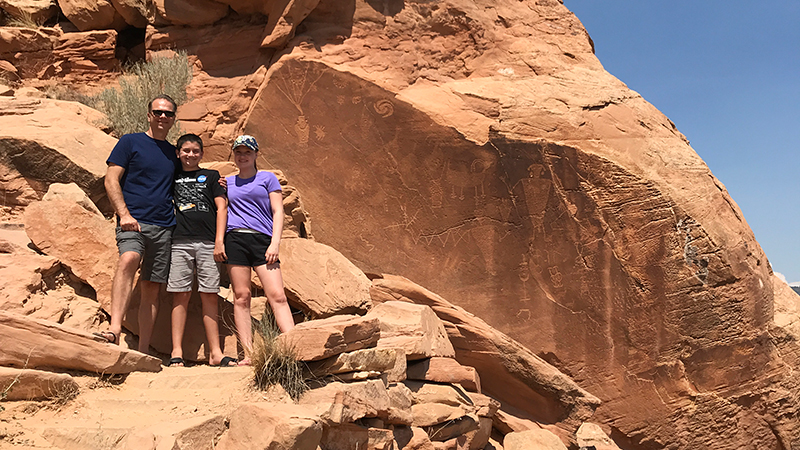
Did you know that Dinosaur National Monument has more than just dinosaur bones and fossils? There are also historic sites, old homesteads, gorgeous canyons, impressive rock formations, sparkling rivers, and, after viewing the petroglyphs at Swelter Shelter, we were excited to see even more petroglyphs along the Tour Of The Tilted Rocks scenic drive.
The Fremont people, who lived in this area approximately a thousand years ago, left evidence of their presence in petroglyphs petroglyphs and pictographs on the rocks.
The Fremont gathered and ate native plants, including pinyon nuts, berries, and cactus fruits. They hunted mule deer, bighorn sheep, small mammals, and birds. The Fremont moved according to the availability of water and food, occupying their dwellings for only part of the year. They also farmed, growing corn, beans, and squash. For at least part of the year, cultivating these plants allowed for a more settled life, which may have given the Fremont the time needed to create the elaborate rock designs seen today.
Fremont designs include both petroglyphs (scratched/carved) and pictographs (painted):
- The region’s sandstone cliffs are darkened with desert varnish, a naturally formed stain of iron and manganese oxides. This provided an ideal canvas for carving petroglyphs and revealing the lighter sandstone beneath. Most of the petroglyph designs are outlines, but some are completely pecked to form solid figures, and a few consist of small holes in closely-spaced rows.
- Pictographs are relatively rare because they are more easily weathered.
On the Tour Of The Tilted Rocks scenic drive, 10.7 miles from the Quarry Visitor Center in the Cub Creek area of Dinosaur National Monument, are petroglyph panels featuring a variety of typical Fremont designs, including several large lizard figures, not common at other sites.
These petroglyphs are only about 50 feet from the road, making it easy to see their detail — and because they’re so close to the road, we could do so fairly quickly, because the sun was high, no shade was to be found, and it was over 100 degrees!
Like those at Swelter Shelter, the Fremont people made the petroglyphs seen on these rocks about 1,000 years ago. Using sharp tools, they pecked away at the rock surface, called desert varnish, to reveal the light-colored sandstone beneath. Some of the designs, such as big horn sheep and other animals are easily recognizeable, but their meaning is not. No one is sure what the ancient artwork means.
About 0.2 miles farther down Cub Creek Road, on the rock ledge high above, is another large concentration of petroglyphs. You can hike the steep 0.25 mile trail to see them up close, use binoculars to see them from the road — or if you have good eyesight, you may be able to see the giant lizard and flute player petroglyphs without binoculars!
Know Before You Go
- The Fremont Petroglyphs located on the Tour Of The Tilted Rocks Scenic Drive, a 12 mile one-way drive along Cub Creek Road in Dinosaur National Monument.
- The drive begins at the Quarry Visitor Center located off Highway 149 at 11625 E 1500 Street, Jensen, Utah 84035 in Uintah County.
- The last two miles of the route are unpaved but well maintained. The last four miles are unplowed in the winter and may not be passable by car December to March.
- Some other stops along the self-guided Tour Of The Tilted Rocks include the Swelter Shelter petroglyphs, Split Mountain viewpoint, the Green River, Turtle Rock and Elephant Toes Butte, the Josie Bassett Morris Homestead, and Box Canyon Trail.
- At the Quarry Visitor Center, pick up the Tour of The Tilted Rocks print guide ($1.00) with information about wildlife, unique rock formations, petroglyphs, and historic sites along the road.
- The guide will tell you to allow at least one hour for the Tour Of The Tilted Rocks Scenic Drive, but it took us almost three because we got out at almost every stop to do some exploring.
- The Visitor Center is open daily from 8:00 am to 6:00 pm during peak season from late May to mid-September and 9:00 am to 5:00 pm during the off season from mid-September to late May. Dinosaur National Monument is closed on Thanksgiving, Christmas, and New Year’s Day.
- On the drive down Cub Creek Road and back, there will be many opportunities to get out and take short walks to get a closer look at the points of interest. Also, wildlife may occasionally be seen, including mule deer, bighorn sheep, pronghorn, prairie dogs, and many bird species.
- Do not touch the petroglyphs and pictographs or proceed past the “End Of Trail” sign. Damaging the ancient artwork or the rocks surrounding them is against the law.
- Fuel, food, and other services are not available along this route. The nearest services are in Jensen, Utah, seven miles south of the Quarry Visitor Center.





